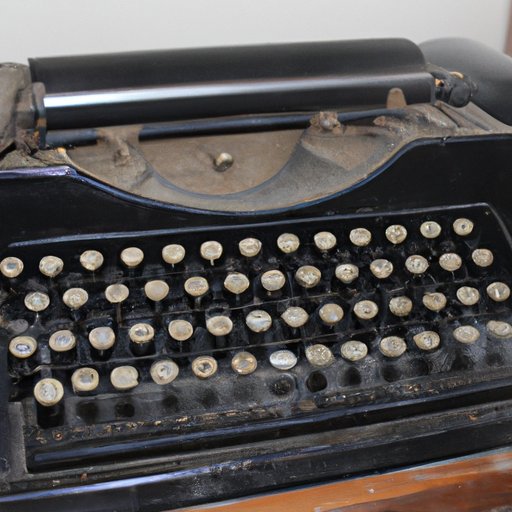Introduction
A typewriter is a mechanical or electromechanical device used for writing characters similar to those produced by printer’s movable type. It has an array of keys, and each one causes a different single character to be produced on the paper, by means of a ribbon with dried ink struck against it by a type element similar to the sorts used in movable type letterpress printing. Most modern typewriters have an electronic, or digital, variant.
The invention of the typewriter has had a profound impact on communication and society as a whole. In this article, we’ll take a historical look at the invention of the typewriter and explore how it has evolved from its inception to present day.

A Historical Look at the Invention of the Typewriter
The origin of the typewriter dates back to 1714 when Englishman Henry Mill filed a patent for an “art of impressing or transcribing letters singly or progressively one after another, so neat and exact as not to be distinguished from print.” However, Mill’s patent was never put into production and the first commercially successful typewriter wasn’t invented until 1867.
In 1867, Christopher Latham Sholes, Carlos Glidden, and Samuel W. Soule patented the first commercially successful typewriter. The machine was known as the Sholes-Glidden Type-Writer and it featured a QWERTY keyboard layout. The keyboard was designed to slow down typists and prevent them from jamming up the keys. This revolutionary machine revolutionized the way people communicated and allowed for faster and more efficient typing.
The typewriter quickly became popular among businesses, journalists, authors, and other professionals who needed to write quickly and efficiently. It was also embraced by the military, government agencies, and large corporations. It was no longer necessary to handwrite documents, which saved time and money.

How the Typewriter Changed the Way We Communicate
The invention of the typewriter changed the way we communicate and ushered in a new era of technology. Before the typewriter, most documents were handwritten, which was a slow and tedious process. With the introduction of the typewriter, documents could be written much faster and more accurately. This allowed for more efficient communication between businesses, governments, and individuals.
The typewriter also made it easier to store, organize, and share documents. Documents could now be typed onto paper, stored in filing cabinets, and easily shared with others. This revolutionized the way information was exchanged and allowed for much more efficient communication.
“The typewriter changed the way people wrote and communicated, and it enabled people to produce more accurate and efficient documents,” says Dr. James B. Taylor, professor of history at the University of California, Berkeley. “It opened up a whole new world of possibilities for writers, business people, and anyone else who needed to communicate quickly and accurately.”

The Impact of the Typewriter on Society
The invention of the typewriter had a major impact on society. It allowed for faster and more efficient communication between businesses, governments, and individuals. It also made it easier to store and organize documents and share them with others. This revolutionized the way people wrote and communicated, and it enabled people to produce more accurate and efficient documents.
The introduction of the typewriter also gave rise to a new industry. Manufacturers began producing typewriters, and the demand for typewriters increased significantly. This led to the creation of new jobs and helped to stimulate the economy.
The typewriter also paved the way for other technological advances. It laid the groundwork for computers, which would eventually become the primary tool for communication and information storage.
Exploring the People Behind the Invention of the Typewriter
Christopher Latham Sholes, Carlos Glidden, and Samuel W. Soule are credited with inventing the first commercially successful typewriter. Sholes was an American inventor and newspaper editor who developed the concept of the typewriter. Glidden was an inventor and businessman who provided financial backing to the project. And Soule was an American inventor and businessman who improved upon the design of Sholes’ typewriter.
These three men had a vision for a better way to communicate and write, and their invention of the typewriter changed the way we communicate forever. Without their vision and hard work, the typewriter might never have been invented.
Conclusion
The invention of the typewriter has had a profound impact on communication and society as a whole. It revolutionized the way we communicate and made it easier to store, organize, and share documents. The typewriter also paved the way for other technological advances such as computers.
We owe a debt of gratitude to Christopher Latham Sholes, Carlos Glidden, and Samuel W. Soule for their vision and hard work. Without them, the typewriter might never have been invented and the world would be a very different place.
(Note: Is this article not meeting your expectations? Do you have knowledge or insights to share? Unlock new opportunities and expand your reach by joining our authors team. Click Registration to join us and share your expertise with our readers.)
